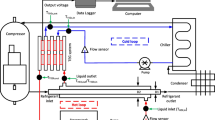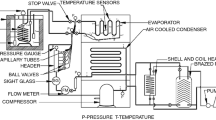Abstract
A high-efficiency evaporator coil, which is placed horizontally between refrigerator and freezer compartments, for household auto-defrost refrigerator-freezers has been developed. Several experiments were performed to investigate the thermal performance of the newly developed compact evaporator coil in a 248l auto-defrost refrigerator-freezer and the results are compared with those of the conventional evaporator. The energy efficiency of the system with newly designed evaporator can be improved by 7%, and the size and material of the evaporator can be reduced by 7% and 40%, respectively, compared with the conventional one.
Similar content being viewed by others
References
Aoki, K. and Hattori, M., 1988, “Analysis on Characteristics of Extended Surface Heat Exchanger with Frosting,”The First KSME-JSME Thermal and Fluid Engineering Conference, Vol. 1, pp. 247–252.
Bansal, P. K. and Kruger, R., 1995, “Test Standards for Household Refrigerators and Freezers I: Preliminary Comparisons,”Int. J. Refrig., Vol. 18, No. 1, pp. 4–20.
Ding, G. and Chen, Z., 1992, “Effects of the Evaporators on the Characteristics of a House-hold Refrigerator-Freezer.”Int. Refrigeration Conference-Energy Efficiency and New Refrigerants, Purdue Univ., Indiana, Vol. 1, pp. 123–130.
Granryd, E., 1992, “Energy Savings in Vapor Compression Refrigerating System,”Int. Symposium on refrigeration, Energy and Environment, pp. 43–60.
Jakobsen, A., 1995,Energy Optimization of Refrigeration Systems: The Domestic Refrigerator-a Case Study, Ph.D. Thesis, Refrigeration Laboratory, The Technical University of Denmark, pp. 77–83.
James, S.J. and Evans, J., 1992, “The Temperature Performance of Domestic Refrigerators,”Int. J. Refrig., Vol. 15, No. 5, pp. 313–319.
Lee, K. S., Jhee, S. and Lee, T. H., 1997, “The Numerical Model for Predicting Frost Layer Growth,”Korean Journal of Air-Conditioning and Refrigeration Engineering, Vol. 9, No. 2, pp. 249–258.
Nowotry, S., 1991,Energy Efficiency in Household Refrigerators Freezers and Commercial Refrigerating Equipment, IIR, Paris, pp. 30–124.
Rite, R. W. and Crawford, R. R., 1991a, “The Effect of Frost Accumulation on the Performance of Domestic Refrigerator-Freezer Finned-Tube Evaporator Coils,”ASHRAE Trans., Vol. 97, Part 2, pp. 428–437.
Rite, R. W. and Crawford, R. R., 1991b, “A Parametric Study of the Factors Governing the Rate of Frost Accumulation on Domestic Refrigerator-Freezer Finned-Tube Evaporator Coils,”ASHRAE Trans., Vol. 97, Part 2, pp. 438–446.
Turiel, I. and Levine, M. D., 1989, “Energy-Efficient Refrigeration and the Reduction of Chloroflurocarbon Use,”Annu. Rev. Energy, Vol. 14, pp. 173–204.
Turiel, I. et al., 1991, “U. S. Residential Appliance Energy Efficiency: Present Status and Future Directions,”Building Equipment and Appliances, pp. 213–234.
Author information
Authors and Affiliations
Rights and permissions
About this article
Cite this article
Kim, MH. Thermal performance of a compact evaporator coil in household refrigerator-freezers. KSME International Journal 12, 486–492 (1998). https://doi.org/10.1007/BF02946364
Received:
Issue Date:
DOI: https://doi.org/10.1007/BF02946364




